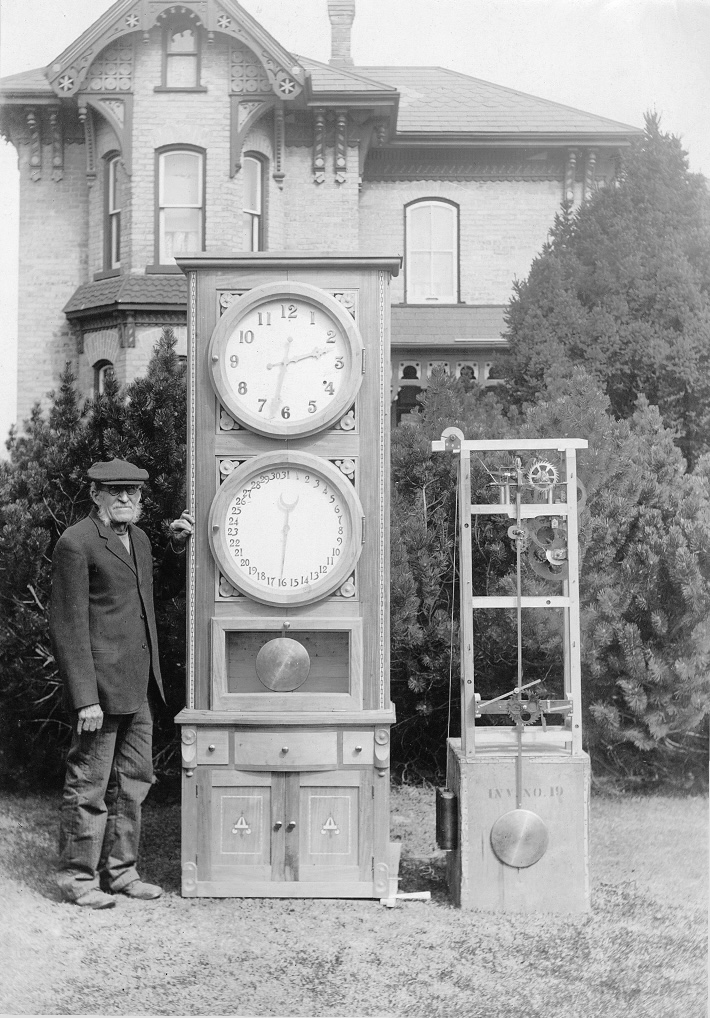Submitted by admin1 on

John K. Lemp was born in Wilmot Township and spent his formative years on the farm of Christian Gingerich on the 13th line of East Zorra Township. In 1881 he married Mary Leonard. They had two children, John who married Lucy Trachsell and Katherine who married John Piehl.
The Lemp family lived at 218 Woodstock Street North in Tavistock in the stately house that John K. built in the late 1800s. Still standing, the home features beautiful inlaid wood floors, a carved bannister and newel post on the main stairway and relief carving below the windows in the sitting room. It was and remains a masterpiece of the woodworker’s art.
Mr. Lemp spent most of his life working at his shop near his home. In the early days he sold and filed saws and repaired machinery for various industrial companies in the community. It was said that he could fix literally anything. He maintained steam engines and with the advent of gasoline power, welcomed the new technology. Every year he took the train to the Toronto Exhibition and spent the whole time he was there studying the new machinery and tools in the industrial exhibits. An out-standing mechanic, John K. built Tavistock’s first horseless carriage in 1908 for the owner of the local milling company.
Those accomplishments notwithstanding, Mr. Lemp is best remembered for his grandfather clocks. Having no special training as a clockmaker, he studied the tower clock, built by noted clockmaker George Hess, at Trinity Lutheran Church in Sebastopol and used it as his inspiration. For many years, one of Mr. Lemp’s many tasks was to keep the church clock in working order.
John K. built his first grandfather clock when he was about 30 years old. He would build four more. All were gifts to members of his family. Distinctive in many ways, the clocks featured two dials … one dial to show the time and the second to show the day of the month.
The clock built for son John, who was a noted photographer and pharmacist in Tavistock, was described in a newspaper article dated April 11, 1938 as follows:
“It is of solid walnut with white maple inlays and, in its ornate case, a pendulum weighing nearly 4 pounds swings back and forth to drive the wheels. The weight within the clock weighs 50 pounds, while the whole clock weighs more than 200 pounds. Cut by hand from sheet steel and solid brass, the cogs and wheels inside the case are notched and geared to perfection. The largest wheel is 9 inches across and not once since the clock was built five years ago has it recorded an inaccurate reading upon the clock’s face. Requiring seven months to make, the towering clock boasts two dials. The top one records the minutes and hours while the second, just below the first, indicates the day of the month. The fact that all moving parts are cushioned in ball bearings promises that the clock shall remain in service for many, many years.”
The picture in this article shows John K. in 1931, at age 72, with two clocks that he made the previous winter.
The mechanisms in all of John K.’s clocks were completely his work. All of the cases were his design. In later years he was assisted by grandson Ernest Piehl of Tavistock. Some cases were made from mahogany and some from walnut. Each showcased John K.’s talent for ornamental wooden inlay work, an intricate and time consuming art using hundreds of pieces of wood. As well, they featured hand-carved rosettes and fancy trim.
For many years one of the grandfather clocks stood proudly in the Tavistock Public Library, on loan from a family member. The case measured 9 feet in height. On that clock the pendulum was a Model T Ford wheel hub hidden by a false plate.
It’s believed that some of the clocks are still with family members. One, built in 1897, is in the lobby of the Queen’s Hotel in Stratford. One is at the Canadian Museum of History in Gatineau (Ottawa). The museum’s website notes that this “long case clock” was made in 1926 by John K. Lemp and Ernest Piehl of Tavistock. It is made of walnut, metal, steel and glass and measures 259 cm high by 92.8 cm wide by 42.5 cm deep. John K., in his quiet unassuming way, would be proud that his clocks are still ticking.